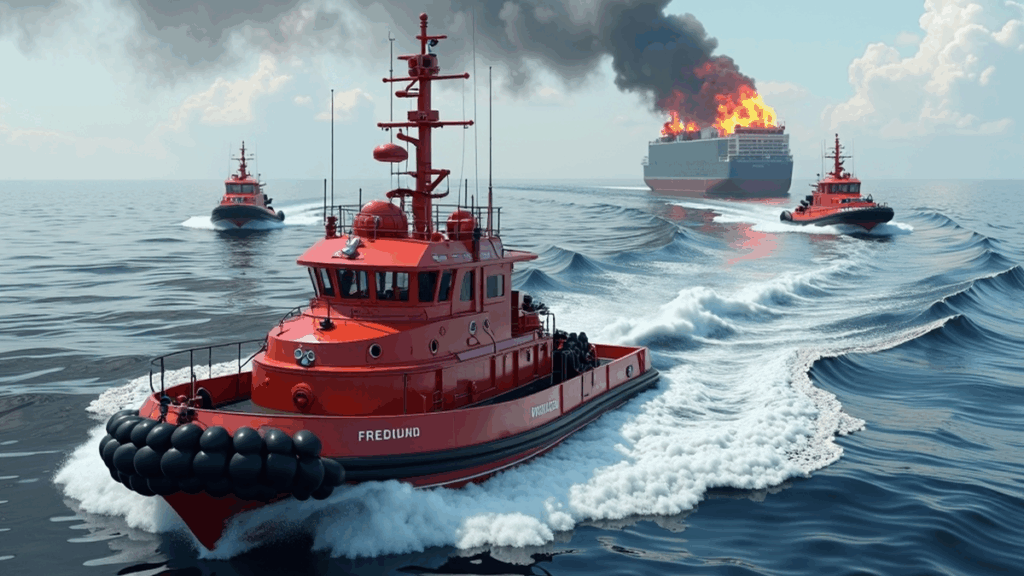Following the annual BTA Conference, Edwin Lampert from Riviera Maritime wrote an article on the launch of the BTA Guide – Use of Tugs in Firefighting. The BTA extends its gratitude to the speakers and Edwin for their expertise and professionalism, which contributed to the success of the conference.

The British Tugowners Association unveiled its watershed Use of Tugs in Firefighting guide in Belfast at its annual conference, confronting head-on a 20% surge in maritime fires which will increasingly involve alternative fuels, new cargo types and electric vehicles.
The 50-page guidance document fills a critical void in marine emergency response protocols during a period of fundamental transition in vessel design and propulsion technologies.
“We’re fighting fires today with tactics and equipment designed for yesterday’s vessels,” warned Boluda Towage Europe chief executive Geert Vandecappelle, highlighting the escalating crisis in car carrier fires. “You will not extinguish an electric car fire with water. The industry must adapt rapidly to these new realities.”
The guide’s publication comes barely two months after the catastrophic North Sea collision between Solong and Stena Immaculate, which created a nightmarish multi-fuel fire scenario that tested response capabilities to their limits. That incident served as a real-world validation of concerns first raised at the BTA conference in 2023 regarding inadequate protocols for emerging maritime firefighting challenges.
The UK Secretary of State’s Representative for Maritime Salvage and Intervention, Stephan Hennig, laid bare the stark reality facing responders, “During the time when no incidents are occurring, you build relationships that help you on the day of a major incident. No single individual can have all the information, all the knowledge in themselves.”
The guide confronts a troubling erosion of maritime firefighting expertise within UK fire services; knowledge diluted through personnel rotations and reduced maritime incident exposure. “Fire services that have a coastline might reasonably expect to respond to ship fires, whether they know about ships or not,” Mr Hennig noted. “That knowledge has been eroded over time for various reasons and is now slowly being built up again.”
Safety practitioner and expert firefighter Ruud Plomp from Artemas Academy delivered an honest assessment of vessel crew capabilities that challenges industry complacency, “Ship crews are not trained to extinguish or control large fires on board. If the fire suppression installation doesn’t work, you need external help – this is where tugs come in.” He dismissed the adequacy of STCW basic firefighting training for crews to manage significant incidents, insisting professional intervention was necessary.
The guide seeks to piece together the fragmented information that previously required companies to assemble protocols from various sources including SIGTTO, the International Chamber of Shipping and IAMSAR conventions. Instead, it provides comprehensive coverage and signposting of equipment specifications, training requirements, liability frameworks, command structures and crucially, practical response tactics for alternative fuel incidents.
The guide addresses a critical first-responder reality: tugs are invariably first on scene, often operating with incomplete information and must collect it from multiple sources as part of a collaborative, multi-organisation effort. “We’re running blind,” Mr Vandecappelle stated. “Our vessels are equipped with cameras; we get images, some kind of idea. We don’t know the problem or the risk.”
Mr Plomp highlighted the realities of some current drill and training regimes he had encountered around the world, “How often do you use your monitors? Half a minute roughly? That’s not enough.” He recounted an exercise where extended monitor use ignited wooden pallets resting against the monitors exhaust pipe; a hazard that short routine testing would never reveal but real firefighting might trigger. Mr Plomp also praised tug operators who invest in their training and conduct regular live exercises.
The guide’s intense 18-month development, with expert input from across classification societies, legal experts, fuel specialists and insurers, reflects the urgency of its mission. Originally scoped as a 12-month project focusing specifically on alternative fuels, the BTA quickly recognised the need to address fundamental gaps in conventional firefighting protocols before tackling emerging challenges. BTA technical representative and commercial director at Targe Towing, Alasdair Smith, noted, “When we asked for volunteers to draft the document, everybody put their hand up. This is an indicator this was definitely a subject people were keen to look at.”
Implementation has already begun, with the guide freely available for download on the UK Chamber of Shipping and BTA websites. Industry attendees described it as “amazing work” deserving “a massive round of applause,” but the BTA is taking a pragmatic approach to its evolution. Mr Smith confirmed there would be disagreement with some content and in places where the guide would be open to interpretation, but it would be an iterative process with an accelerated revision cycle, acknowledging the breakneck pace of technological change.
“We’re not just preparing for the future – we’re catching up with the present,” concluded Mr Smith, encapsulating the industry’s recognition that alternative fuels are already transforming operational realities across the maritime sector. “These aren’t abstract risks for tomorrow. They’re in our ports right now.”
The article can be found on Riviera’s website here – Riviera – News Content Hub – Tug guide stems fighting today’s fires with yesterday’s tactics
With gratitude to Edwin Lampert and Riviera for granting permission to the BTA to publish the article.


